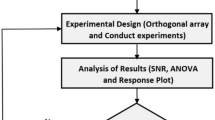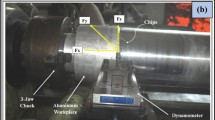Abstract
Because of the random distribution of diamond abrasive grains on the surface and the obstruction of chip flow during processing, conventional grinding tool cannot meet the requirements of the machining precision. Therefore, the emergency of special grinding tools such as surface structured grinding wheels improves the machining precision. In this study, rhombus textured grinding tools with different arrangement angles α are manufactured, the grinding mechanism of them is studied, the penetration depth model and grinding force model are established, and the grinding performance of conventional grinding tool and rhombus textured grinding tools are compared. It can be found that when α = 50°, the surface quality of the rhombus textured grinding tools for grinding single crystal silicon and BK7 is significantly better than that of conventional grinding tool, and the surface roughness of single crystal silicon machined by rhombus textured grinding tool is 20.2–37.4% smaller than that of conventional grinding tool. The instantaneous grinding forces of the two kinds of tools are compared, they both conform to the sinusoidal change, but the amplitude of the instantaneous grinding force of conventional grinding tool is at least 22.1% bigger than that of the rhombus textured grinding tool with α = 50°. Furthermore, the average grinding force of the rhombus textured grinding tool with α = 50° is not only very stable, but also much smaller than that of conventional grinding tool. Finally, in order to verify the average grinding force model, the test value of the average grinding force of the rhombus textured grinding tool with α = 50° and the predicted value of the model are compared, when the cutting depth is 20 μm and the material is single-crystal silicon, the average error in the x direction and y direction are 15.2% and 19.0%, respectively.



















Similar content being viewed by others
Availability of data and materials
All data generated or analyzed during this study are included in this submitted article.
Code availability
Software application.
Abbreviations
- L :
-
Length of the rhombus unit
- w :
-
Width of the rhombus unit
- w d :
-
Width of overlapping area between rhombus units
- W :
-
Width of the grinding tool
- R tool :
-
Radius of the grinding tool
- Δy :
-
The center distance in vertical direction between two adjacent rows of rhombus units
- α :
-
The angle between the line of the center point of a column of rhombus units and the vertical direction
- L i :
-
The distance between adjacent grains in the (i)th row
- p 0 :
-
The maximum grain penetration depth
- p 0, t :
-
Instantaneous penetration depth of grain at time t
- ω :
-
Angular speed of the grinding tool
- v w, v s :
-
Velocity of workpiece and grinding tool
- s :
-
The amount of translation of the workpiece in the time interval when the grinding tool is rotated through the two adjacent grains
- a p :
-
Radial cutting depth
- a z :
-
Axial cutting depth
- n :
-
Rotation speed of grinding tool
- θ″:
-
Grain phase angle at time t
- d s :
-
Grain diameter
- b 1, b 2 :
-
Grain bottom and top widths respectively
- H t :
-
The total height of single grain
- S c :
-
Projection area of grain
- β :
-
Friction angle
- γ :
-
Grain rake angle
- φ :
-
Shear angle
- τ s :
-
Shear strength of the workpiece
- σ c :
-
The convential flow stress of the material
- w r, w c , r :
-
The number of grain rows in one rhombus unit and the number of grains in that row
- n r, n c :
-
The total number of rows and columns of rhombus units
- F c, F p :
-
Tangential and normal grinding forces respectively
- G ( i , j ) ,( p , q ) :
-
The position of the (j)th grain in the (i)th row of the rhombus unit in (p)th row (q)th column
- ψ ( i , j ) ,( p , q ) :
-
The phase angle of G(i,j),(p,q) at time t
- F c , t ,( i , j ) ,( p , q ) :
-
The momentary cutting force of G(i,j),(p,q)
- F p , t ,( i , j ) ,( p , q ) :
-
The momentary plowing force of G(i,j),(p,q)
- f s :
-
Sampling frequency of the dynamometer
- t pr :
-
Time of the tool per rotation
References
Malkin S, Guo C (2008) Grinding technology: Theory and application of machining with abrasives. McGraw-Hill, USA
Rowe WB (2013) Principles of modern grinding technology. Elsevier Science Netherlands
Macaulay WT (1923) Segmental grinding wheel. US patent US1663310
Denkena B, Grove T, Göttsching T, Silva EJD (2014) Enhanced grinding performance by means of patterned grinding wheels. Int J Adv Manuf Technol 77(9–12):1–7
Yuan HP, Gao H (2008) On the control and optimisation of abrasive distribution pattern on grinding tool surfaces. Int J Mater Prod Technol 31(1)
Yuan HP, Gao H, Bao YJ, Wu Y (2009) Grinding of carbon/epoxy composites using electroplated CBN wheel with controlled abrasive clusters. Key Eng Mater 389–390:24–29
Yuan HP, Gao H, Liang YD (2010) Fabrication of a new-type electroplated wheel with controlled abrasive cluster and its application in dry grinding of CFRP. Int J Abrasive Technol 3(4):299–315
Yu HY, Lu YS, Wang J (2018) A biomimetic engineered grinding tool inspired by phyllotaxis theory. J Mater Process Technol 251:267–281
Yu HY, Wang J, Lu YS (2016) Simulation of grinding surface roughness using the grinding wheel with an abrasive phyllotactic pattern. Int J Adv Manuf Technol 84(5–8):861–871
Yu HY, Lu YS, Wang J (2016) Study on wear of the grinding tool with an abrasive phyllotactic pattern. Wear 358:89–96
Lu YS, Wang J, Liu YM, Xing XL (2014) Development of a novel polishing pad with a phyllotactic pattern, and experimental studies. J Electron Mater 43(7):2738–2746
Hugo WHB (1925) Segmental grinding wheel. US patent US1526953
Oliveira JFG, Silva EJ, Guo C, Hashimoto F (2009) Industrial challenges in grinding. CIRP Ann Manuf Technol 58(2):663–680
Aurich JC, Herzenstiel P, Sudermann H, Magg T (2008) High-performance dry grinding using a grinding wheel with a defined grain pattern. CIRP Ann Manuf Technol 57(1):357–362
Tawakoli T, Rabiey M (2008) An innovative concept and its effects on wheel surface topography in dry grinding by resin and vitrified bond CBN wheel. Mach Sci Technol 12(4):514–528
Sugihara T, Enomoto T (2009) Development of a cutting tool with a nano/micro-textured surface—improvement of anti-adhesive effect by considering the texture patterns. Precis Eng 33(4):425–429
Li HN, Axinte DA (2016) Textured grinding tools: a review. Int J Mach Tools Manuf 109:8–35
Spampinato A, Axinte D, Butler-Smith P (2017) On the performance of a novel dressing tool with controlled geometry and density of abrasive grits. CIRP Ann Manuf Technol 66(1)
Oliveira JFG, Bottene AC, França TV (2010) A novel dressing technique for texturing of ground surfaces. CIRP Ann Manuf Technol 59(1):361–364
Butler-Smith PW, Axinte DA, Daine M (2011) Ordered diamond micro-arrays for ultra-precision grinding—an evaluation in Ti-6Al-4V. Int J Mach Tools Manuf 51(1):54–66
Cheng J, Wang C, Wen XL (2014) Modeling and experimental study on micro-fracture behavior and restraining technology in micro-grinding of glass. Int J Mach Tools Manuf 85:36–48
Cheng J, Yu T, Wu J (2018) Experimental study on ductile-brittle transition in micro-grinding of single crystal sapphire. Int J Adv Manuf Technol 98:3229
Umeno Y, Kitamura T (2017) Ab initio simulation on ideal shear strength of silicon(electronic devices). Apcfs & Atem 2(1):929–934
Hou ZB, Komanduri R (2003) On the mechanics of the grinding process—part I. Stochastic nature of the grinding process. Int J Mach Tools Manuf 43:1579–1593
Gordon JR, William CH (1985) Fracture characteristics of three metals subjected to various strains, strain rates, temperatures and pressures. Eng Fract Mech 21(1):31–48
Cheng J, Wu J, Gong YD (2016) Grinding forces in micro slot-grinding (MSG) of single crystal sapphire. Int J Mach Tools Manuf 112:7–20
Goddard J, Wilman H (1965) A theory of friction and wear during the abrasion of metals. Wear 5:114
Sin H, Saka N, Suh NP (1979) Abrasive wear mechanisms and the grit size effect. Wear 55(1):163
Acknowledgements
The authors would like to thank the support of DONGGUAN SENYONG DIAMOND TECHNOLOGY Co., LTD, China.
Funding
This work was supported by the National Natural Science Foundation of China (grant number 51575096) and the China Fundamental Research Funds for the Central Universities (grant number N180304014).
Author information
Authors and Affiliations
Contributions
Jun Cheng contributed to the conception of the study; Zhaozhi Guo performed the data analyses and wrote the manuscript; Jun Wu performed the experiment; Xifeng Zhang and Baoyu Liu helped perform the analysis with constructive discussions.
Corresponding author
Ethics declarations
Ethics approval
Waivers.
Consent to participate
Not applicable.
Consent for publication
The author confirms the publication of this paper has been approved by all co-authors, and its publication has been approved by the responsible authorities at the institution where the work is carried out.
Competing interests
The authors declare no competing interests.
Additional information
Publisher's Note
Springer Nature remains neutral with regard to jurisdictional claims in published maps and institutional affiliations.
Rights and permissions
About this article
Cite this article
Guo, Z., Cheng, J., Wu, J. et al. Modeling and experimental study on the grinding performance of precision diamond grinding tool with defined texture. Int J Adv Manuf Technol 124, 737–758 (2023). https://doi.org/10.1007/s00170-021-08372-w
Received:
Accepted:
Published:
Issue Date:
DOI: https://doi.org/10.1007/s00170-021-08372-w




